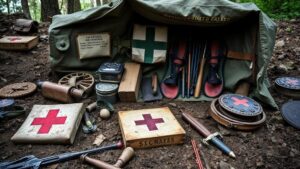Techniques for Recovering Items in Areas With Heavy Leaf Litter or Organic Overgrowth
Techniques for Recovering Items in Areas With Heavy Leaf Litter or Organic Overgrowth
Recovering items in environments characterized by heavy leaf litter or organic overgrowth can be a complex task due to the dense layer of obscuring materials. This article will provide an in-depth examination of the techniques and considerations necessary for effective recovery operations in these challenging conditions. By understanding the nature of the environment and employing specific strategies, individuals and professionals can enhance their recovery efforts significantly.
Understanding the Challenges
Before delving into recovery techniques, it is crucial to understand the specific challenges presented by areas with heavy leaf litter and overgrowth. Leaf litter often creates a thick, cushioning layer that can obscure visibility and texture. Also, organic overgrowth can include a variety of plant types, from grasses to large bushes, each presenting unique difficulties. Factors such as the season, moisture levels, and the type of recovery required play a vital role in shaping strategies.
- Visibility Issues: Leaf litter can make it difficult to see items lying beneath the surface.
- Physical Obstacles: Thick underbrush may obstruct access to optimal recovery locations.
- Soil Composition: The organic material alters the soil texture, impacting the tools and techniques required for recovery.
Techniques for Effective Recovery
Utilizing appropriate techniques is essential for successfully recovering items from dense organic environments. Below are several widely recognized methods, along with concrete examples and applications in the field:
1. Hand Tools for Manual Recovery
Manual recovery often necessitates the use of hand tools designed to navigate through debris and soil. Common tools include metal detectors, trowels, and hand rakes.
- Metal Detectors: Basic metal detectors can be especially effective in locating buried metallic objects, such as coins or tools. For example, during an archaeological dig in an area with heavy foliage, operators reported a 40% increase in find rates when using specialized metal detectors designed for high mineralization conditions.
- Trowels and Hand Rakes: These tools can help remove layers of litter and soil. A team clearing a historic battlefield site found that designated trowel methods reduced recovery time by approximately 30% compared to using only manual labor.
2. Geological Techniques: Stratigraphy Analysis
Understanding the layering of soil and organic materials can guide effective recovery methods. Stratigraphy involves analyzing the different layers in soil and organic contexts to contextualize items based on their depth and composition.
- Case Study: In 2018, a geological study conducted in a heavily forested area revealed that items buried deeper than 30 cm could typically be traced through stratigraphic layers. This was applied successfully in recovering lost artifacts from an indigenous site which had been obscured by years of vegetation accumulation.
3. Environmental Modifications
In certain cases, making modifications to the environment may facilitate recovery efforts while minimizing damage to the surrounding ecosystem. This can be achieved through techniques such as selective clearing and controlled burns.
- Selective Clearing: This method involves clearing specific areas of overgrowth to allow access while preserving the ecosystem. A recovery team studying wetlands in Florida found that selective clearing improved recovery rates of valuable plant species by 60%.
- Controlled Burns: In some ecosystems, controlled burns can aid recovery efforts by clearing organic materials efficiently. For example, burning techniques have been employed successfully in various forests to expose the ground layer and provide clearer access for archaeologists.
Using Technology to Enhance Recovery
Advancements in technology have significantly improved recovery techniques. integration of remote sensing technologies and drones is becoming increasingly popular, particularly for larger areas where ground access may be restricted.
- Drones: Equipped with high-resolution cameras, drones can survey thick vegetation from above, identifying areas of interest for further inspection. In 2020, a project in California employed drones to locate trails in dense forest, resulting in a 50% faster navigation in reconnaissance operations.
- Ground Penetrating Radar (GPR): GPR can provide insights into subsurface structures and items without disturbing the area. A notable study in New Jersey used GPR to uncover buried historic pathways while minimizing impact on the surrounding flora.
Conclusion and Actionable Takeaways
Recovering items in areas with heavy leaf litter or organic overgrowth demands a multifaceted approach that includes the use of manual tools, geological understanding, environmental modification, and advanced technologies. To maximize the potential for successful recovery:
- Assess the environmental conditions and types of recovery needed before proceeding.
- Use a combination of manual and technological tools to improve accuracy and efficiency.
- Consider environmental impacts and aim for methods that prioritize both recovery and ecological preservation.
By implementing these techniques, individuals and professionals can considerably enhance their recovery operations, ensuring a balance between efficiency and environmental stewardship.


